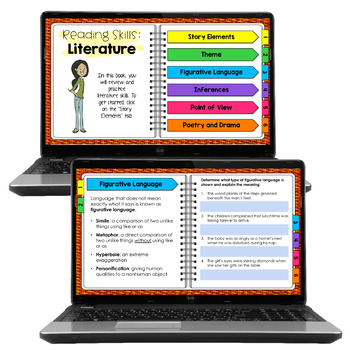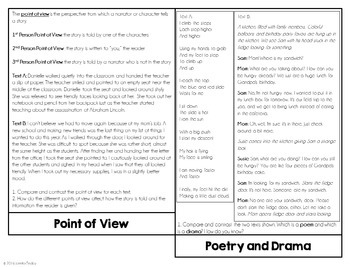
In this review of the literature on e-learning, we present and discuss definitions of e-learning, hybrid learning and blended learning, and we review the literature comparing different online teaching formats with traditional on-campus/face-to-face teaching. With this point of departure, we explore which factors affect students’ learning experiences in different online formats in higher education, with particular Apr 12, · The research studies chosen for this literature review focused on attitudes of faculty teaching via distance learning and more specifically, the perceptions that faculty have regarding motivators and inhibitors of teaching via online distance learning. Three main databases were employed to search for relevant research blogger.com by:
Literature Review – Faculty Participation in Online Distance Education: Barriers and Motivators
TaylorDirector of Learning, Teaching and Innovation at Cranleigh School. Dr Taylor is leading a free CIRL professional development webinar on project-based learning, on 17 November from pm GMT.
This blogpost offers a literature review on online distance learning, which is thematically divided into four sections. I first consider what the literature tells us about the efficacy of online distance learning section 1 and the importance of building a learning community section 2. Educators have traditionally expressed scepticism about the prospects of reproducing outcomes equivalent to traditional face-to-face instruction by means of online distance learning, according to Paul VanPortfliet and Michael Anderson.
In a study comparing outcomes from online and hybrid courses, VanPortfliet and Anderson note that it is believed that academic achievement and retention are worse for students following distance learning programmes than for those being taught in traditional classroom settings.
An explanation cited for this relative lack of efficacy traces it back to a lack of contact between students, their teacher and their peers in the online learning environment. A meta-analysis by Cathy Cavanaugh et al of effect sizes measured across 14 K web-delivered distance learning programmes between and found that there was no significant difference in outcomes between virtual and face-to-face schools.
A study by Heather Kauffmann explored factors predictive of student success and satisfaction with online learning. VanPortfliet and Anderson note that research into hybrid instruction indicates that students achieve outcomes that match, if not exceed, outcomes from other instructional modalities. In particular, academic achievement by students in hybrid programmes is consistently higher than that of students engaged in purely online programmes.
The ongoing discussion in the literature suggests that it is difficult to draw general conclusions about the efficacy of online learning as such, not least because it constitutes in significant ways a distinctive mode of learning when compared with real-world instruction. It is perhaps better, then, to look more specifically at questions such as the comparative strengths and challenges of moving to virtual schooling, the conditions which need to be in place for it to function well and the manner in which this transition is experienced by learners with different capabilities.
A helpful summary of research about online learning by Jonathan Beale at CIRL contains an outline of principles concerning successful online distance learning programmes. The summary explores research-based recommendations for effective teaching and learning practices in online and blended environments made by Judith V. Boettcher and Rita-Marie Conrad in their work, The Online Teaching Survival Guide: Simple and Practical Pedagogical Tips. Why is presence so important in the online environment?
When faculty actively interact and engage students in a face-to-face classroom, the class evolves as a group and develops intellectual and personal bonds. The same type of community bonding happens in an online setting if the faculty presence is felt consistently. This can be accomplished through effective individual and group communication, encouraging engagement in the course, productive and growth-focused feedback, and multiple opportunities for students to ask questions and learn in a way that is meaningful to them.
Research into virtual learning emphasises the importance of the connection between students and their teachers. As Beale notes, this does not necessarily mean that every lesson needs to include a video meeting, distance learning literature review, though there is a beneficial psychological impact of knowing that the teacher is still in contact and regular face-to-face online discussions can enable this.
There are other forms — a discussion thread which begins during a lesson and is open throughout can perform the same role, though in cases where meeting functions are available, students may be directed to use these rather than email. As well as the teacher-student relationship, student-student links are important.
There is evidence of improved learning when students are asked to share their learning experiences with each other. Distance learning is challenging for students and the experience can be frustrating distance learning literature review de-motivating if technology fails e.
More than ever, teachers need to work at providing positive distance learning literature review to their students, praising and rewarding success and acknowledging challenges when they exist. It is also valuable if teachers can identify new skills that students are acquiring — not least skills in problem-solving, distance learning literature review, using distance learning literature review technology and resilience — and encourage their classes when they see evidence of these.
Given distance learning literature review, more or less by definition, students participating in an online distance learning literature review learning programme will be operating with a greater degree of autonomy, it may be expected that those who will be best suited to online learning will be those with the greatest propensity for self-regulated learning.
This view is advanced in a review of the literature on virtual schools up untilby Michael Barbour and Thomas Reeves:. The benefits associated with virtual schooling are expanding educational access, providing high-quality learning opportunities, improving student outcomes and skills, allowing for educational choice, and achieving administrative efficiency.
However, the research to support these conjectures is limited at best. The challenges associated with virtual schooling include the conclusion that the only students typically successful in online learning environments are those who have independent orientations towards learning, highly motivated by intrinsic sources, and have strong time management, literacy, and technology skills. These characteristics are typically associated with adult learners.
This stems from the fact that research into and practice of distance education has typically been targeted to adult learners. Given the lack of evidence noted by Barbour and Reeves, a more cautious conclusion would be that we may expect to find a relationship between outcomes from online distance learning programmes and the propensity distance learning literature review students for self-regulated learning, rather than distance learning literature review conclusion that this capacity is a precondition of success.
Kauffmann notes that students with the capacity for self-regulated learning tend to achieve better outcomes from online courses. This result is not surprising, given that in online learning more responsibility is placed on the learner. A review of 35 studies into online learning by Jacqueline Wong et al explores the connection between online learning and self-regulated learning, distance learning literature review.
The study highlights the significance of supports for self-regulated learning such as the distance learning literature review of prompts or feedback in promoting the development and deployment of strategies for self-regulated learning, leading to better achievement in online learning:.
In online learning environments where the instructor presence is low, learners have to make the decisions regarding when to study or how to approach the study materials. Taking a more student-centred approach during online instruction fits with features of the online environment, distance learning literature review.
It is natural to make more use of asynchronous assignments and to expect students to take more responsibility for their study, given that they are not subject to direct supervision in a classroom setting and may be accessing course materials outside of a conventional timetable.
A controlled study in distance learning literature review Ruchan Uz and Adem Uzun of undergraduate students on a programming language course compared blended learning with a traditional learning environment. The study found that, for the purpose of developing self-regulated learning skills, blended instruction was more effective than traditional instruction.
In a review of 55 empirical studies, Matthew Bernacki, Anita Aguilar and James Byrnes noted that research suggests that:. Their review suggests that the use of technologically enhanced learning environments can promote self-regulated learning and that such environments are best used by learners who can self-regulate their learning.
However, an investigation by Peter Serdyukov and Robyn Hill into whether online students do learn independently argues that independent learning requires active promotion as well as a desire to promote autonomy on the part of the instructor and the necessary skills and motivation on the part of students. Where these conditions are not met, the aspiration to autonomy is frustrated, which can lead to negative outcomes from the online learning experience.
Bernacki, distance learning literature review, Aguilar and Brynes employed an Opportunity-Propensity O-P framework. The O-P framework was introduced by Brynes and Miller in a paper exploring the relative importance of predictors of math and science achievement, where it was described as follows:.
This framework assumes that high achievement is a function of three categories of factors: a opportunity factors e, distance learning literature review. It is plausible to suggest that the two-way relationship between self-regulated learning skills and successful participation in an online distance learning programme can be explained in terms of the opportunities online distance learning offers in three areas: first, to develop self-regulated learning skills afforded by the online distance learning environment; second, the prior propensity of learners to self-regulate their learning; and third, changes in distal factors such as exclusive mediation of learning through online platforms to IT and parental involvement in learning.
It is fair to say that the move to an entirely distance learning programme is the single biggest and most rapid change that many educators will ever have had to make. As with any large-scale rapid and fundamental innovation, it is hard to get everything right, distance learning literature review.
We need to be willing to revise and refine. This may mean adapting to use a new software platform across the whole school if problems are found with existing provision, or it may be an adjustment to expectations about lesson length or frequency of feedback.
Keeping distance learning programmes under review is also essential as we look towards a possible future in which it will co-exist with face-to-face teaching. In that report, the literature review is used to establish several conclusions about the implementation of online learning programmes.
Those findings are compared to trends discernible in the responses distance learning literature review a questionnaire survey of three year groups at Cranleigh School years 9, 10 and The programme of study for these year groups was designed to provide continuity of delivery of the curriculum, in contrast to the programmes developed for years 11 and 13, where a customised programme of study was developed to bridge the gap created by the withdrawal of national public examinations during the summer term of Barbour and Thomas C.
Loyens, Joshua Magda and Remy M. Bernacki, Anita C. Online Distance Learning: A Literature Review. Back to all blogs. Next up The Teaching and Learning Summit 7th July
Distance Learning - How to Teach Guided Reading Virtually
, time: 46:08Online Distance Learning: A Literature Review | CIRL

The research studies chosen for this literature review focused on attitudes of faculty teaching via distance learning and more specifically, the perceptions that faculty have regarding motivators and inhibitors of teaching via online distance learning. Three main databases were employed to search for relevant research blogger.com by: LITERATURE REVIEW 4 Distance learning systems are increasingly used by organizations as an approach for enhanci ng workers’ skill and due to cost-down effect in replacing traditional training. From organizatio n management, distance learning systems provide most beneficial tool May 20, · Watts, L. (). Synchronous and asynchronous communication in distance learning: A review of the literature. Quarterly Review of Distance Education, 17(1), 23– Google Scholar Zawacki-Richter, O., & Naidu, S. (). Mapping research trends from 35 years of publications in distance education. Distance Education, 37(3), –Cited by: 17

No comments:
Post a Comment